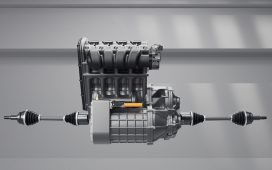This study includes a coupled modelling framework representing the European energy system in a detailed manner with possibility of hydrogen imports from neighbouring regions. Moreover, methane footprint of natural gas and its derivative products are taken into account via the methane emission factor calculation module. The modelling represents the energy system from the primary energy source (crude oil, wind, solar, etc.) until the end-use energy form consumed (electricity, heat, etc.) in each sector (buildings, transport, industry and agriculture) including different primary energy supply options, energy transformation technologies, different primary and secondary energy carriers (electricity, hydrogen, coal, etc.) and energy storage options. The modelling framework is based on economic optimisation of the whole energy system including imports: minimisation of the cost of energy supply until consumption point over the outlook period (2016-2050). Therefore, taking into account the economic and technical characteristics of the overall energy system, the model finds the least-cost technology mix to meet the energy demand of each sector, considering sector coupling (interdependencies between different sectors, energy carriers and their supply options, and conversion technologies). Therefore, it takes into account both the competition over the scarce energy sources (such as Bioenergies) and the synergies of coupling between different sectors.
The modelling framework
The modelling consists of the detailed European energy system optimisation model and a hydrogen delivery chain optimisation model that enables imports of hydrogen to Europe. The energy system optimisation model (MIRET-EU) represents the European energy system based on linear programming at country level, with a detailed representation of all technologies. The hydrogen delivery chain optimisation model represents the cost of hydrogen production and its export to Europe from neighbouring regions allowing competition between different clean hydrogen supply technologies (wind- or solar-based renewable hydrogen, low-carbon hydrogen based on methane reformation with carbon abatement and low-carbon hydrogen based on methane pyrolysis) and their origins: Europe, North African countries and Middle Eastern countries. Moreover, it includes the competition between different hydrogen transport routes (gaseous hydrogen via pipelines or liquified hydrogen and ammonia via shipping) to assess the least-cost hydrogen import routes. Via methane emissions calculation module, the modelling framework also accounts for the methane footprint of natural gas and low-carbon hydrogen, both produced in Europe and imported from neighbouring regions Europe.
The MIRET-EU model
MIRET-EU is a dynamic energy system optimisation model that represents European energy system in a detailed manner from primary energy sources until the final energy in its consumed form. It optimises the investments in different energy supply, transformation, transport and storage through the period 2010 to 2050 to estimate least-cost capacity investment pathways based on the TIMES generator. It is a bottom-up economic model that combines technical engineering and economic approaches. The modelling considers linear programming to produce and results in a least-cost energy system across regions and sectors based on environmental (GHG emissions), political, resource-related and technical constraints over medium to long term. Such a modelling exercise gives important insights on long-term investment decisions in futuristic complex systems where technologies and energy infrastructure are set to evolve and vary from their current versions.
The modelling exercise is based on perfect market competition and perfect foresight regarding the future events, which means that the investment decisions are made based on full knowledge of future events with no information assymetry50. Findings of such a modelling exercise can support decision-making processes regarding the competitivity of different technologies in the energy industry and can provide reliable grounds for the exploration possible futures of the European energy system following different policy, resource and technology scenarios. The modelling framework of the MIRET-EU model follows the evolution of the TIMES framework successively in the RES2020’s Pan European TIMES model51 and the JRC-EU-TIMES52, MIRET-FR53 and TIAM-IFPEN18,54,55,56,57 models with additional technology-specific constraints in the transport sector, refineries and bioenergy conversion technologies, hydrogen infrastructure, power sector and industrial processes.
MIRET-EU studies the evolution of the European energy system in the period between 2010 and 2050 with 10-year optimisation time steps. As a part of this optimisation concerns past dates, the 2010–2020 period is calibrated and fine-tuned using the latest constraints (COVID-19 pandemic, Russia-Ukraine war, etc.) and data from the most well-known energy databases such as the JRC-IDEES (The EU’s Joint Research Centre’s Integrated Database of the European Energy System), POTEnCIA (Policy Oriented Tool for Energy and Climate Change Impact Assessment), EUROSTAT, and other databases published by international organisation such as IEA, IRENA, and the World Bank.
For clarity in the final charts, we set the reference year to the previous mid-decade (i.e., 2016) for benchmarking comparisons with existing data in all sectors and all countries. The significance of the findings remains in the development of the European energy system in 2030 considering the current policies and latest political measures, but also beyond, in the year 2050. The model considers the existing technologies which are related to what is already installed in all considered countries in the historical period (i.e., the 2010s period), and the new technologies which are to be available in the future (e.g., from 2020 onwards). Spring, summer, fall, and winter are the four seasons considered by MIRET-EU, with each season broken down further into day, night, and peak resolution (it follows the same time-slice disaggregation as in the world multiregional model TIAM-IFPEN). Hence, each year is broken down into twelve time-slices that roughly correspond to the average daytime, night-time, and peak demand for each season (e.g., summer day, summer night and summer peak, etc.). The model is disaggregated into 27 countries (24 EU member states and 3 non-EU countries) Each country has its own energy system with its main demand sectors.
MIRET-EU provides in-depth, specific technological descriptions of each country’s energy system from the primary resources (uranium, crude oil, coal, natural gas, biomass, renewables, and traded hydrogen) to the end-use sectors. It encompasses all stages through the chain of processes that transform, transport, distribute and convert energy into energy vectors and energy services. It includes the electricity generation technologies (all power plants from fossil-based to renewable energy sources) fuel production, primary and secondary energy sources, as well as imports and exports. Petroleum products, electricity, natural gas, hydrogen, and CO2 captured may all be traded between countries. Energy is supplied to the demand side, which is composed of residential, commercial, agricultural, transportation, and industrial sectors, via various energy carriers (electricity, fossil fuels, e-fuels, heat, hydrogen, bioenergy, and other renewables). A package of measures and constraints such as quality standards for refinery products, the functioning hours of power plants, global emission constraints or sectoral restrictions, has also been considered in MIRET-EU. More information on the MIRET-EU model and the considered sectors and technologies as well as the cost parameters can be found in Supplementary Information 1.
The HyPE model
HyPE is a hydrogen delivery chain optimisation model with high spatial (0.5°) and temporal resolution (hourly time slices for at least one full year) grounded on the literature on international hydrogen trade45,58,59,60. The model finds cost-efficient pathways to balance point-to-point hydrogen demand. By representing the competition between hydrogen production technologies, production locations, the costs incurred for transport and logistics, and other abatement costs (i.e., CO2 and methane emission), the model finds optimal investments in production technologies, use of resources, domestic supply and hydrogen tradeflows18.
Following the European hydrogen strategy, only low-carbon and renewable hydrogen imports are considered, with a focus on the closest neighbouring regions: North Africa, the Middle East and Ukraine. The calculation of renewable hydrogen is as follows: The neighbouring regions were divided in a 0.5° grid where solar, wind, biomass and natural gas resources are assessed to compute levelized costs of hydrogen (LCOH—the levelized cost of hydrogen adopts the life cycle costing methodology where all related costs and produced quantities are included to compute an average ratio of cost per kilogram produced):
$${{LCOH}}_{{tech},y,{country}}=\frac{{{CAPEX}}_{{tech},y}+\mathop{\sum }\nolimits_{t=1}^{{{lt}}_{{tech}}}\frac{{{OPEX}}_{{tech},y}}{{\left(1+{{WACC}}_{{tech},y,{country}}\right)}^{t}}}{\mathop{\sum }\nolimits_{t=1}^{{{lt}}_{{tech}}}\frac{{E}_{{tech},{cell}}}{{\left(1+{{WACC}}_{{tech},y,{country}}\right)}^{t}}}$$
(1)
$${E}_{{tech},{cell}}=\mathop{\sum }\limits_{h=1}^{8760}{{CF}}_{h,{tech},{cell}}\times \frac{1}{{\eta }_{{electrolysis}}}$$
(2)
Where:
$$\left\{\begin{array}{c}{{CAPEX}}_{{tech},{y}}:\hfill {{{\rm{Initial}}}} \; {{{\rm{investments}}}} \; {{{\rm{for}}}} \; {{{\rm{a}}}} \; {{{\rm{given}}}} \; {{{\rm{production}}}} \; {{{\rm{technology}}}}\; {tech}\; {{{\rm{on}}}} \; {{{\rm{year}}}}\;{y} \hfill \\ {{OPEX}}_{{tech},{y}}:\hfill {{{\rm{Maintenance}}}} \; {{{\rm{and}}}} \; {{{\rm{operational}}}} \; {{{\rm{costs}}}} \; {{{\rm{for}}}} \; {{{\rm{a}}}} \; {{{\rm{given}}}}\;{tech}\;{{{\rm{and}}}} \; {{{\rm{year}}}}\;y \hfill \\ {{WACC}}_{{tech},{y},{country}}:\hfill {{{\rm{Weighted}}}} \; {{{\rm{Average}}}} \; {{{\rm{Cost}}}} \; {{{\rm{of}}}} \; {{{\rm{Capital}}}} \; {{{\rm{in}}}} \; {{{\rm{the}}}}\;{country}\;{{{\rm{and}}}} \; {{{\rm{year}}}}\;{y}\;{{{\rm{per}}}} \; {{{\rm{t}}}}{ech}\hfill\\ {E}_{{tech},{cell}}:\hfill {{{\rm{Annual}}}} \, {{{\rm{energy}}}} \, {{{\rm{output}}}} \, {{{\rm{per}}}} \, {tech} \, {{{\rm{on}}}} \, {{{\rm{a}}}} \, {{{\rm{production}}}} \, {cell} \, {{{\rm{in}}}} \, {{{\rm{kilograms}}}} \, {{{\rm{of}}}} \, {{{\rm{hydrogen}}}}\\ {{CF}}_{h,{tech},{cell}}:\hfill {Capacity\; Factor}-{{{\rm{Energy}}}} \; {{{\rm{produced}}}} \; {{{\rm{out}}}} \; {{{\rm{of}}}} \; {{{\rm{one}}}} \; {{{\rm{kW}}}} \; {{{\rm{of}}}} \; {{{\rm{capacity}}}} \; {{{\rm{installed}}}},\hfill\\ {{{\rm{in}}}}\; {{{\rm{kWh}}}},\; {{{\rm{per}}}} \; {{{\rm{hour}}}}\;h,\; {tech}\;{{{\rm{on}}}} \; {{{\rm{a}}}} \; {{{\rm{production}}}}\; {cell} \hfill \\ {\eta }_{{electrolysis}}:\hfill {{{\rm{Consumption}}}} \; {{{\rm{of}}}} \; {{{\rm{electricity}}}} \; {{{\rm{of}}}} \; {{{\rm{the}}}} \; {{{\rm{electrolyser}}}} \; {{{\rm{in}}}} \; {{{\rm{kg}}}}/{{{\rm{kWh}}}} \hfill \\ {{lt}}_{{tech}}:\hfill {{{\rm{Lifetime}}}} \; {{{\rm{of}}}} \; {{{\rm{the}}}} \; {{{\rm{production}}}} \; {{{\rm{technology}}}} \; {tech} \; {{{\rm{considered}}}}\hfill\end{array}\right.$$
Adding the transport options between different countries (considering the retrofitted natural gas pipelines and maritime transport via liquified hydrogen and ammonia including the needed conversion and reconversion costs) the transport routes are identified and optimised. The hydrogen import potential in Europe is obtained in the form of a supply curve for each possible delivery point.
Following an economic optimisation, the competition between different hydrogen export options to Europe including potential big demand hubs (such as China and Southeast Asia) has been assessed to mimic the potential competition on hydrogen resources. The import supply curves are used by the energy system model to represent the competition between European domestic production and imports. More information on HyPE and calculation of LCOH for green and blue hydrogen can be found in Supplementary Information 2.
Methane emission scenarios and emission factor calculation
Methane emissions along the natural gas value chain were estimated for over 30 countries, including upstream, downstream and LNG processes where relevant. The methane emission scenarios were developed to provide scenarios extending from baseline to best case scenario. The first scenario, Current Emission Factors (CEF), represents the current best understanding level of emissions in the countries. Information from country level academic papers61,62, with significant measurements and estimates, emissions reported to UNFCCC63 and IEA methane tracker64 were leveraged to develop a concrete understanding of emissions from the gas sector in each country. A decision matrix was used to select the best source of information in each case (please refer to Supplementary Information 3 for further information). Following this, the emissions from the different steps of the natural gas value chain were summed up separately and divided by the volume of natural gas produced, transported, or imported, to estimate the EF of each step. This scenario, called Current Emission Factors (CEF), presents the average EF per country and forms the “baseline” for other scenarios to be developed from. The EF is considered flat through the period until 2050 in this scenario.
The second scenario, Harmonised Pledges (HP), is the intermediary scenario between current emission factors and an optimistic best available technology deployment scenario. It includes the effect of country policies34,35, NDCs36 relevant to GHG emission reductions and international pledges37,38,39,40 (International Pledges such as: (a) Zero flaring by 203037 (b) Methane Pledge38 (c) Methane Alliance39) published as of 2023. In this scenario, the changes in the EFs from the preliminary year (2019) to 2050 are assessed based on the announced policies and pledges. Depending on their policies and participation in international pledges, countries are grouped in four categories: countries with relevant GHG emission reduction policy and international pledges, countries with relevant GHG emission reduction policy but without international pledges, countries without policy relevant for GHG emission reduction and only international pledges and countries with no policy nor international pledges. For the first category, we apply the policy reduction goal by the target year and then, the optimistic target within international pledges. For the countries in the second category, the existing policy or NDC target is applied by the target year and the EF remains flat beyond the policy date until 2050. We apply the Zero Routine Flaring to the countries in the third category by 2030 and the less optimistic target among the signed international pledges beyond 2030. The EFs of the countries in the last category, however, remain flat between 2019 and 2050.
The final scenario, Best Available Technologies (BAT), represents the EFs that could be achieved assuming BAT deployment along the natural gas value chain by a certain year. The number of years required to reach this scenario’s EFs changes by country, however a minimum of 10 years is assumed to reach BAT EF for all countries. IEA abatement potential64, industry targets set in the countries assessed, or global industry targets65 were considered to estimate the impacts on EF from the preliminary year (2019) to 2050. Either IEA’s methane tracker data or OGCI industrial targets were used to identify the EFs for this scenario, depending on the data availability. A more detailed explanation of methane emissions calculation methodology and the scenarios can be found in Supplementary Information 3.
The calculated methane emission factors are implemented in MIRET-EU for the three scenarios (BAT, HP and CEF). Under the GHG emission reduction constraints, the evolution of the energy system is optimised independently for each of the three scenarios, assuming that the measures deployed to limit methane emissions are taken for granted. Hence, the investments needed to reach lower methane EF along the natural gas value chain are exogenous to the optimisation but are evaluated ex post for each scenario and compared to the achieved cost reduction of the whole energy system when lower EF are implemented in the optimisation (see the Discussion section).
The choice of global warming potential period for methane leakage
The global warming potential of methane should be assessed considering the horizon of the climate target66. For a climate-neutrality objective in 2050, the methane concentration in the atmosphere should be stabilised by 2045, and the period from the assessment date (2023) to this date (2045) should be considered as reference global warming potential assessment period, which is 22 years. Therefore, we chose GWP20 as the reference for translation of methane emissions in CO2eq terms.
Carbon capture and storage potential
The annual CO2 storage capacity is assessed based on the values suggested in the existing literature. The assessment considers two key parameters: total available geologic potential (overall European cumulative CO2 storage capacity) and the dynamic rate of increase in annual CO2 storage capacity (based on drilling and sequestration capacities). The United Kingdom18 and Norway18 contain the largest CO2 storage potentials in Europe each with offshore storage capacity as high as 70 GtCO2. Regarding the annual injection rates, the analysis of potential for scaling up CO2 storage on the Norwegian continental shelf shows that only Norwegian offshore wells have an average injection rate capacity of 0.695 ± 0.222 Mt/year67. Following the analysis carried in Hydrogen for Europe study68, we estimate that only in Norway, 2083 wells could be active by 2050 which corresponds to an available injection rate of about 1.4 GtCO2/year by 2050. Following the technical, political and social acceptability uncertainties on the development of carbon capture and storage, the maximal annual CO2 storage capacities are set to 1 GtCO2/year in 2040 and 1.4 GtCO2 /year by 2050 across Europe.
Policy assumptions
Several assumptions made in the modelling are key to understand the observed evolution of the European energy system. The most structuring ones concern the energy policies adopted and proposed at the European level, which are assumed to be mandatory in the model. For the CO2 and methane emissions from natural gas value chain, an overall progressive reduction is implemented. Following the European Fit-for-55 directive, a 55% reduction of GHG emissions by 2030 (compared to 1990 levels) and reaching net-zero by 2050 targets are implemented. Sectoral GHG emission reduction goals are also included for both EU ETS (reduction by 21% in 2020 compared to the 2005 levels including aviation and by 43% in 2030) and non-ETS (ranging between 0% and −40% in 2030 compared with 2005 levels in order to achieve a collective 30% reduction of the total EU emissions) sectors, as well as for passenger transport (target for the EU fleet-wide average emissions is set at 95 gCO2/km).
Regarding the share of renewable energy in gross final energy consumption, a target of 40% is set for 2030, complemented by a specific target for the transport sector, following the revised RED II directive of the European Commission: for the period 2030 to 2050 the target is set to 14%. The contribution of biofuels produced from food and feed crops (1st Generation) is capped at 7% of road and rail transport fuel in each Member State from 2020 onwards. Furthermore, the contribution of advanced biofuels and biogas (2nd Generation) should be at least 0.2% in 2022, at least 1 % in 2025 and at least 3,5 % in 2030 (as a share of the final consumption of energy in the transport sector). Finally, an objective of 32.5% energy efficiency in 2030 compared to a European business-as-usual scenario is also considered. All these targets for emission reduction, renewable energy share and energy efficiency are aligned with European climate goals: Fit-for-55, European Green Deal and European climate legislation.
More recently, the REPowerEU plan announced a strategy to phase out energy supply from Russia for geopolitical and sovereignty reasons. To reflect this strategic independence decision, a zero Russian import constraint from 2025 is implemented for natural gas and hydrogen in the modelling. For coal and oil, no specific supply restriction is included as their contribution to Europe’s energy supply is anyway reduced following the emission reduction constrains.
Data assumptions
Naturally, a direct impact of the Russia-Ukraine conflict and associated supply restrictions on fossil fuel prices can be expected. Therefore, the initial prices trajectories based on the STEPS (Stated Policies) scenario of the IEA World Energy Outlook 202168 are adjusted in the short-term: oil ICE and natural gas TTF future prices are used to represent the expected peak in prices of these commodities between 2022 and 2025, before stabilising on the STEPS price path by 2030, that will follow until the end of the modelling window (see Fig. 7). Coal prices remain unchanged as this commodity is the fastest to be phased out and its prices are less dependent on imports.
Short term oil and natural gas prices are expected to peak in reaction to the war in Ukraine and of the supply restriction. Long term prices paths follow the IEA STEPS scenario69. STEPS is one of three key scenarios of the International Energy Agency, standing for stated policies.
The hydrogen production technologies and the related cost and efficiency data can be found in the annex E (Data documentation, p.162-164) in the Hydrogen for Europe study68. More detailed information on taken assumptions and the overall database can be found in Supplementary Information 1.
Reporting summary
Further information on research design is available in the Nature Portfolio Reporting Summary linked to this article.











